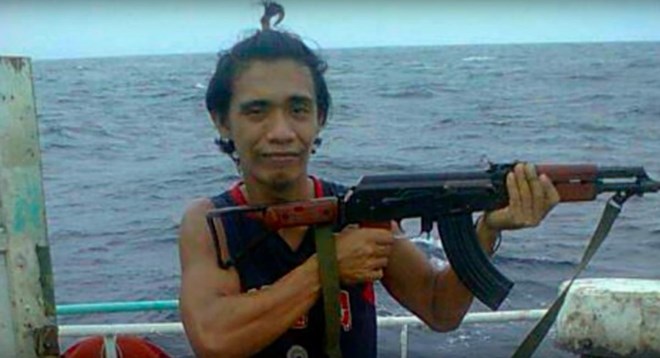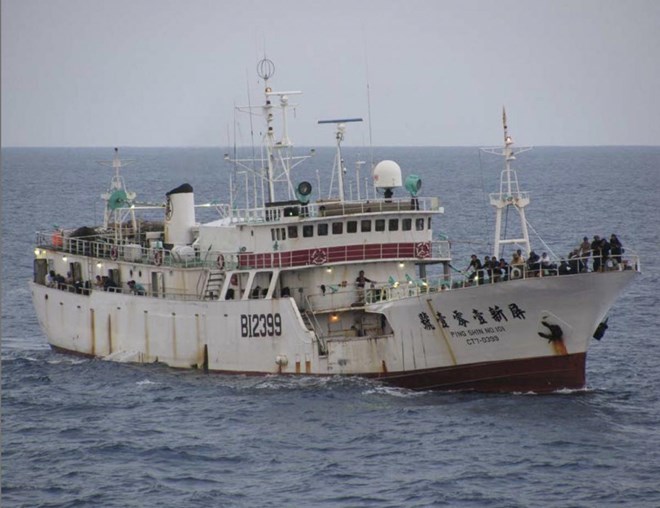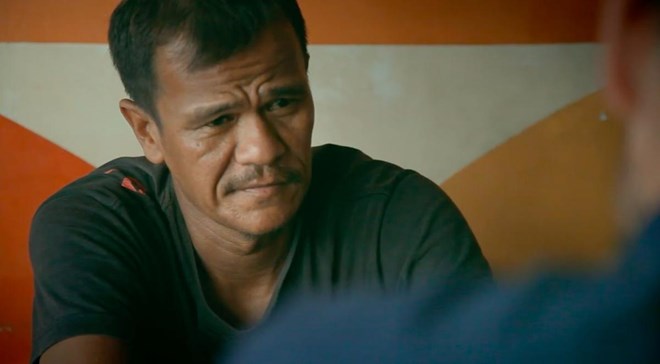
Monday November 16, 2020
By Ian Urbina

Aldrin, a cook on the Ping Shin 101. Picture: Karsten Von Hoessin
The men are helpless in the open water, clinging to floating debris, tossed by the rolling waves. Several large fishing ships circle. None of the victims has a life jacket, but no-one makes a move to help. This isn’t a rescue.
A voice, off camera, shouts in Mandarin: “In the front, to the left! What are you doing?” Then: “Fire! Fire! Fire!”
Bullets spray the water around one flailing man. One round catches him. His body stills. Blood plumes in the blue ocean. Later, deckhands laugh and pose for photos.
Grainy video of the 2012 killings, which shows the slaughter of at least four men in the Indian Ocean, has been circulating in the darker corners of the internet for years. Now, authorities in Taiwan have arrested a suspect: a 43-year-old Chinese national whom they believe to be the man who shouted the orders to kill. Investigators hope he leads them to others.
But the case, which is still unfolding, shows the challenge of prosecuting crimes on the high seas. There were at least four tuna longliner ships on the scene of an incident that unfolded over more than 10 minutes in broad daylight. But no law required any of the dozens of witnesses to report the killings – and no-one did. Law enforcement in the open ocean is limited, and jurisdiction is complicated. Authorities learned of the killings only when the video turned up on a phone left in a taxi in Fiji in 2014.
It’s still unclear who the victims were, or why they were shot. An unknown number of similar killings takes place each year – deckhands on the ship from which the video was shot told a private investigator, and later a documentary crew on camera, that they’d witnessed a similar slaughter a week before.
Wang Feng Yu, believed to have been the captain of the Taiwanese-flagged Ping Shin 101 during the attack, was taken into custody by the Taiwanese coast guard in August after his current ship docked at Kaohsiung port. He’s being held while prosecutors investigate.
“Now that we have the captain, we have a more direct way of questioning him about the whole ordeal,” Tseng Ching-ya, spokeswoman for the Kaohsiung District Prosecutor’s Office, told the Central News Agency in Taiwan.
Hsu Hung-ju, the deputy chief prosecutor in Kaohsiung, told The Washington Post that such investigations normally take six to eight months. “It depends on the case,” he said. “But it won’t take too long.”
Hsu declined to say whether prosecutor Hsu Hung-pin had interviewed witnesses. Though he refused to provide a name, Hsu also said that Wang has a lawyer.
The footage, shot from the Ping Shin in what appears to be the aftermath of a wreck, is chilling. One man in the water raises his arms over his head, palms open, in what looks like an attempt to surrender. A bullet drills into the back of his head, knocking him facedown. His body floats, lifeless.
Gunmen with semi-automatic weapons appear to fire at least 40 rounds. “I’ve shot five!” one shouts in Mandarin.
Trygg Mat Tracking, a Norwegian research firm that focuses on maritime crime, identified the Ping Shin 101 by comparing video footage with images in a maritime database. Former deckhands were identified through Facebook and other social media platforms where they had discussed their time onboard. Interviews with these former deckhands, some of whom said they witnessed the killings captured in the video, revealed the name of the captain and details of the incident.

Ping Shin 101, the Taiwanese ship carrying the gunmen involved in the murder. Picture: Fish-I Africa
Officials from the Indian Ocean Tuna Commission, which licenses commercial fishing in the region where the killings occurred, and the Taiwanese flag registry, which is responsible for enforcing laws on Taiwanese-flagged ships, declined to provide information about the crew, the captains at the scene, the ships’ routes or their recent ports of call.
Taiwanese officials, presented with the names of the men and ships in 2015 and 2016, said the victims appeared to be part of a failed pirate attack. Tzu-yaw Tsay, then the director of the Taiwanese fisheries agency, questioned whether the killings were murder. “We don’t know what happened,” Tsay said at the time. “So there’s no way for us to say whether it’s legal.”
But maritime security analysts caution that the claim of piracy has been used to justify attacks for a range of alleged offences, real or otherwise. The victims, they say, might have been crew members who had mutinied, thieves caught stealing or simply rival fishermen.
“It is nearly impossible to police the open ocean, and sometimes people take matters into their own hands, as was the case here,” said Klaus Luhta, vice-president of the International Organization of Masters, Mates and Pilots, a seafarers’ union. He noted that the men appeared to be unarmed and defenceless, and not pose a threat.
“Whether this was some sort of vigilante justice or cold-blooded killing for reasons unknown,” he said, “we see clearly it is a vicious murder at sea.”
Such killings will continue to go unchecked, Luhta said, without better tracking of offshore violence, more transparency from flag registries and fishing companies, and more effort by governments to prosecute the perpetrators.
Prosecuting such crimes matters, US Naval Academy historian Claude Berube said, because what occurs at sea affects everyone. By some estimates, 90 per cent of world trade is moved by sea, and seafood is a major source of protein for much of the world.
If dumping oil intentionally, fishing in prohibited waters, enslaving deckhands, or killing on camera go unpunished, Berube said, ship operators which are willing to break the law gain a competitive advantage. He said lawlessness at sea makes consumers complicit in human rights and environmental abuses.
“The public should be concerned with crimes at sea because those crimes don’t start or stop at sea,” Berube said. “They have land-based networks that affect lives and economies.”
But lawbreaking can be countered only when it’s reported, that rarely happens offshore. Shipping and fishing companies, maritime insurers, private security firms, embassies and flag registries track violence at sea to varying degrees, but there’s no single comprehensive centralised or public database.
The Stable Seas programme of the Colorado-based One Earth Future Foundation has been granted access to much of that information. Former US Navy officer Jon Huggins, a senior adviser to the programme, says the data includes a variety of crimes: robbers siphoning fuel, hijackings, human trafficking, piracy.
When programme officials tried to convince the groups that gathered the data to make it available to the public, Huggins said, they pushed back. Risk-management companies asked why they should share data they could sell instead. Coastal states worried it might scare away business. Flag registries were reluctant to release information that might oblige them to act, which they had little motivation or ability to do.
Complaints of crime at sea are rare. Berube lists the reasons: many ships lack the insurance that would make reporting worthwhile; captains resist prying investigations that can cause delays; most countries lack blue-water navies or coast guards that patrol beyond their territorial limits; and they have neither the financial ability to patrol international waters of uncertain jurisdiction, nor much interest in doing so.
“We saw those challenges with Somali piracy a decade ago,” Berube said. “Merchant ships were largely told that they were on their own, and they took on private security teams in the absence of national or international support.”

Maximo, crew member on the Ping Shin 101 and alleged witness to the killing. Picture: Karsten Von Hoessin
Nonetheless, much has been learned about the 2012 killings. Two Filipino deckhands on the Ping Shin 101 named Aldrin and Maximo — they shared only one name — told a private investigator on camera that they witnessed the killings. In the video, Maximo can be seen smiling and posing for selfies after the shooting. He wears an oversize blue T-shirt that reads “Hang 10”. A deckhand on the Chun I 628, another ship at the scene, also described the incident.
The Ping Shin was fishing in the Indian Ocean somewhere between Somalia and Seychelles in August 2012, Aldrin and Maximo told private investigator Karsten Von Hoesslin in videotaped interviews, when it received a radio alert that a nearby ship had come under attack by pirates. It was unclear which ship was being attacked; there was yelling back and forth, the witnesses said. The supposed pirates seemed to be unarmed.
Deckhands aboard the Ping Shin 101 opened fire, and the men in the smaller boat jumped into the water. Some began yelling that they were not a threat. “No Somali!” one deckhand heard them say. “No pirates!”
Wang was the captain of the Ping Shin 101. He was in his 30s, young for a captain. He had a dragon tattoo on his left arm. Deckhands called him “Captain Hoodlum”.
“He was a rough guy,” one told Von Hoesslin, director of a security company called the Remote Operations Agency. “He hits people.”
Aldrin said Wang had a ferocious temper: “He punched, then kicked, if you did a mistake.”
According to ship tracking records, the 165ft Ping Shin 101 was owned by a Shanghai business executive named Lee Chao Ping, principal of the Ping Shin Fishery Co Ltd in Kaohsiung. Efforts to reach Lee were unsuccessful. Online records show that the business closed in 2018. A security guard at its former address said in September that there was a Ping Shin or Ping Hsin fishery in the building some years ago but that the office had since closed.
Interpol and a private investigation firm that specialises in maritime crime have also been unable to find Lee.
Duncan Kawino, who said he worked on the Ping Shin 101 when it docked in Mombasa, Kenya, in 2013, said it fished mostly in Somali waters, but reported that its catch came from Seychelles waters, where he said it had a licence. The Ping Shin 101 and the Chun I 628 had three armed guards each, all Pakistani, the witnesses said. The video shows at least four men being killed, but Aldrin and Maximo said it’s likely that more were shot — possibly 10 to 15.
The witnesses said the victims probably weren’t pirates. “They didn’t have any guns, only fishing equipment,” Maximo said. “It was wrong, people getting shot. But there was nothing I could do.”
Nor was it an isolated incident. A similar confrontation occurred a week earlier, Aldrin said. The circumstances he described on camera for a documentary series were virtually the same – alleged pirates were rammed, shot and killed, their bodies left floating in the water. A video that apparently captured the earlier attack was discovered by Trygg Mat Tracking, the Norwegian research firm.
The Ping Shin 101 eventually ended up on the ocean floor. The vessel sank on July 7, 2014, less than two years after the shootings captured on the video. Wang, still the captain, broadcast a distress signal citing a mechanical failure. “Something exploded,” one crew member said on camera.
Taiwanese authorities issued an arrest warrant for Wang in December 2018. In August, prosecutors got their break. A tuna longliner called the Indian Star, owned by a Taiwanese company and flagged to Seychelles, arrived in Kaohsiung. The fishing ship had a history of violations, including using forged licences and fishing in forbidden areas.
More important to authorities, though, was the man who captained the vessel. Wang Feng Yu stepped ashore, and was arrested.